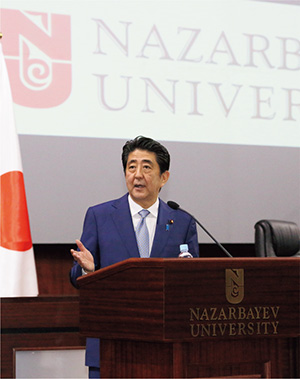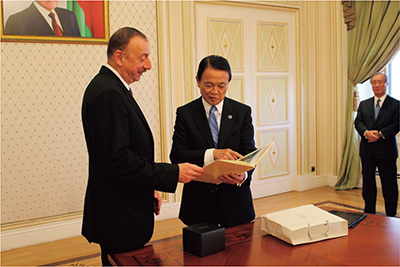Diplomatic Bluebook 2016
Chapter 2
Japan’s Foreign Policy that Takes a Panoramic Perspective of the World Map
2.Central Asian and Caucasian Countries
(1) Central Asian Countries
As a part of Japan’s foreign policy that takes a panoramic perspective of the world map, Prime Minister Abe visited five countries in Central Asia from October 22 to 28, 2015. Prime Minister Abe visited Uzbekistan and Kazakhstan for the first time in nine years, and the visits to Turkmenistan, Tajikistan, and Kyrgyzstan were the first visits ever as a Prime Minister of Japan. The visits included summit meetings with the presidents of the countries, the announcement of joint bilateral statements, and the offering of flowers to the cemetery of Japanese detainees. Through these events, the leaders confirmed the bond between Japan and Central Asia.
To conclude the visits, Prime Minister Abe made a policy speech in Kazakhstan, the last destination, regarding Japan’s basic policy on diplomacy towards Central Asia. There, he presented a three-point message as regards Japan’s foreign policy toward Central Asia, consisting of (1) strengthening relations dramatically with nations of Central Asia, (2) Japan’s active involvement to resolve the challenges faced universally by the Central Asia region, and (3) deepening the partnership between Japan and Central Asia on the global stage. Also, all of the five states welcomed Japan’s foreign policy that helps Central Asia achieve an “open, stable, and autonomous development” and contributes to the peace and stability of the region and world. In particular, Uzbekistan President Islam Karimov stated that he highly valued Japan’s diplomacy based on Proactive Contribution to Peace.
The private companies and university officials accompanying this visit numbered fifty groups. Business forums took place in Turkmenistan, Uzbekistan and Kazakhstan. Total of 87 public and private documents were signed and each of the forums were attended by Prime Minister Abe and his counterparts, thus backing Japanese companies to develop their business in Central Asia.
In March, before the Prime Minister Abe’s visit to Central Asia, a symposium titled “Chance and Challenge: Looking for the future in Central Asia” had been held to raise public awareness of Central Asia among Japanese citizens.
Japan’s relations with each of the countries in Central Asia have been generally favorable. The following visits were made from Japan to Central Asia; Parliamentary Vice-Minister for Foreign Affairs Sonoura visited Kyrgyzstan and Kazakhstan (April), Uzbekistan (July) and Turkmenistan (August); State Minister of Economy, Trade and Industry Daishiro Yamagiwa visited Turkmenistan (June); Parliamentary Secretary for Ministry of Land, Infrastructure, Transport and Tourism Keisuke Suzuki visited Uzbekistan (September); Deputy Chief Cabinet Secretary Hiroshige Seko visited Turkmenistan (December) to attend the 20th anniversary ceremony of the Neutrality of Turkmenistan. From Central Asia, President of Turkmenistan Berdimuhamedov visited Japan to participate in the meeting of the 3rd World Conference on Disaster Risk Reduction (Sendai, March). In addition, there were active high-level visits including the visits to Japan by the following persons: Uzbekistan First Deputy Prime Minister and Finance Minister Azimov (January), Turkmenistan Deputy Prime Minister Hojamuhamedov (July), Uzbekistan Foreign Economic Relations, Investments and Trade Minister Ganiev (October), and Turkmenistan Railways and Transportation Minister Anna Meredev (December).
 Prime Minister Abe giving a policy speech (October 27, Kazakhstan; Photo: Cabinet Public Relations Office)
Prime Minister Abe giving a policy speech (October 27, Kazakhstan; Photo: Cabinet Public Relations Office)(2) Caucasian countries
The relations with Caucasian countries were further strengthened as well. As for Georgia which shares values of liberty and democracy with Japan and seeks integration with Europe, Japan began to call the country “Georgia” in place of “Gruzia” last April. In May, Parliamentary Vice-Minister for Foreign Affairs Sonoura visited Georgia, and formally exchanged verbal notes regarding the measures to exempt diplomatic visas between the two countries. In November, Georgian Defense Minister Tinatin Khidasheli visited Japan.
With abundant natural resources, Azerbaidjan leads the economy of the Caucasus area. State Minister for Foreign Affairs Minoru Kiuchi (January), Deputy Prime Minister and Minister of Finance Taro Aso (May) (attending the general meeting of the Asian Development Bank (ADB)), and Minister in charge of Economic Revitalization Akira Amari (October) visited the country. From Azerbaidjan, Speaker of the National Assembly Ogtay Asadov (April) and Vice Prime Minister Ali Shamil Oglu Hasanov (August) visited Japan. The bilateral relations were enhanced through these increasingly active high-level mutual visits.
 Deputy Prime Minister and Minister of Finance Aso’s meeting with Azerbaijan President Aliyev (May 4, Azerbaijan; Photo: Finance Ministry)
Deputy Prime Minister and Minister of Finance Aso’s meeting with Azerbaijan President Aliyev (May 4, Azerbaijan; Photo: Finance Ministry)Armenia enjoys rich human resource, particularly in the IT field. In January, at the opening of the Embassy of Japan in Armenia, State Minister for Foreign Affairs Kiuchi visited the country. A variety of related events took place both in Tokyo and Yerevan to commemorate the opening of the Embassy enhancing momentum for bilateral relations.
Meanwhile, Caucasian countries are burdened with disputes over territories including South Ossetia and Abkhazia2 in Georgia, and the Nagorno-Karabakh Problems3 between Azerbaijan and Armenia, which still cause tensions among the countries involved. Although efforts toward resolution have been made, any progresses are still invisible.
- 2 In August 2008, an armed conflict took place between Georgia and South Ossetia; the latter was aiming for separation and independence from the former. Russia intervened in the dispute, which led to a military conflict between Georgia and Russia. About one week after the conflict occurred, France, which was then EU president, and other states acted as mediators and brought about a ceasefire. Based on the agreement reached at that time, international conferences have been held in Geneva to discuss security and humanitarian issues among parties concerned.
- 3 Most of the residents living in the disputed Nagorno-Karabakh area, who requested belonging to Armenia rather than Azerbaijan. This led to a dispute between the two countries following the dissolution of the Soviet Union in 1991. Armenia had occupied almost the entire region of Nagorno-Karabakh and the surrounding seven areas by 1993. In 1994, the two countries agreed to a ceasefire through the intermediation of Russia and the OSCE; however, conflict with casualties has been repeated until now. Since 1999, an intermediation of the OSCE Minsk group has allowed direct talks between Armenia and Azerbaijan at various levels, including their leaders and foreign ministers.
